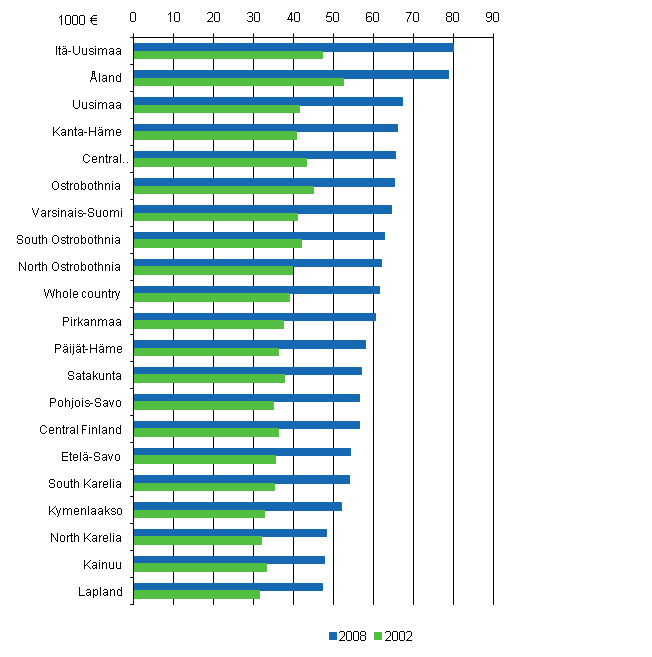Published: 2 July 2009
Debts grew by 7.7 per cent in 2008
The rate at which household-dwelling units became indebted slowed down somewhat in 2008; yet their debts grew by nearly eight per cent from the previous year. There were 1,470,000 household-dwelling units with outstanding debts, or good two per cent more than in the year before. Household dwelling units’ debts have grown by 81 per cent in real terms since 2002. They grew most in 2005, when the total debts of household dwelling units increased by 14.7 per cent and their housing loans went up by 17.5 per cent.
Last year, household-dwelling units’ outstanding debts totalled EUR 90.5 billion, of which the majority of EUR 64.4 billion were housing loans. The amount of debt per indebted household-dwelling unit was EUR 61,630. Household-dwelling units with housing loans numbered 812,000, of which 136,000 were first-time buyers. The amount of housing loan per household with a housing loan was EUR 79,321, while among first-time home buyers the amount was EUR 75,750.
Housing loans have grown most since 2002, or by 99 per cent in real terms. Most of the growth in housing loans appears to have come from existing home sales, as housing loans taken out by first-time buyers grew more slowly; their volume went up by 71 per cent in real terms since 2002. However, since 2007 housing loans taken out by first-time buyers grew faster than other housing loans.
The rate of indebtedness of household-dwelling units, that is, the share of their debts of their disposable income, was 101.4 per cent in 2007, while in 2002 it was 70.3 per cent. Among indebted household-dwelling units debts amounted to 147 per cent and among household-dwelling units with housing loans to 203 per cent of annual income. The rate of indebtedness was highest, or 189 per cent of income, among households in which the reference person was aged between 25 and 34. Approximately four in five of such households had outstanding debts, while the respective proportion among all households was 59 per cent. The 35 to 44 age group had the largest debts of EUR 89,200 per household-dwelling unit. Apart from the youngest and oldest age groups, well over one-half of households in all other age groups had outstanding debts. Exclusive of the very youngest age group, the share of indebted households has grown in all age groups since 2002.
Examined by region, households in Itä-Uusimaa and Åland had the largest debts of approximately EUR 80,000 per indebted household. By comparison, housing loans per household with a housing loan were largest in Uusimaa, at EUR 101,440, Itä-Uusimaa, at EUR 97,250 and Åland, at EUR 88,920. Debts have also increased most in Itä-Uusimaa where debts per indebted household grew by 70 per cent in real terms between 2002 and 2008. The growth was next largest in Uusimaa where they went up by 62 per cent in real terms. Over the same time period debts in the whole country grew by 58 per cent. Housing loans also increased most in Itä-Uusimaa, where they went up by 70.5 per cent per household with a housing loan whereas in the whole country they grew by 62 per cent in real terms. Debts per indebted household-dwelling unit were smallest in Lapland, at EUR 47,160, Kainuu, at EUR 47,800 and North Karelia, at EUR 48,300. Since 2002, the numbers of indebted households have increased most the regions of Uusimaa, Kanta-Häme and Pirkanmaa and least in those of Eastern Finland, Northern Finland and Satakunta.
Total loans per household-dwelling unit with a loan by region 2002 and 2008 at 2008 prices

The amount of average debt, as well as the number of indebted households, increased as the level of income went up. In 2007, approximately one-third of household-dwelling units in the lowest income quintile had debts, while the respective proportion in the two highest quintiles was 74 per cent. In the lowest income quintile the average amount of debt was EUR 23,460 and in the highest quintile EUR 95,800 per household-dwelling unit. The rate of indebtedness was highest in the lowest and lowest in the highest income quintile, but the differences were not very large: in the lowest income quintile, debts of indebted households amounted 158 per cent and in the highest income quintile to 137 per cent of annual income. There were larger differences in the composition of debts: the share of housing loans of all debts was highest among households with median income, while other debts and study loans accounted for the largest share of debts among low-income households and business debts among high-income households.
Source: Indebtedness 2008. Statistics Finland
Inquiries: Timo Matala (09) 1734 3422
Director in charge: Riitta Harala
- Tables
-
Tables in databases
Pick the data you need into tables, view the data as graphs, or download the data for your use.
Updated 2.7.2009
Official Statistics of Finland (OSF):
Indebtedness [e-publication].
ISSN=2489-3285. 2008. Helsinki: Statistics Finland [referred: 19.4.2025].
Access method: http://stat.fi/til/velk/2008/velk_2008_2009-07-02_tie_001_en.html

